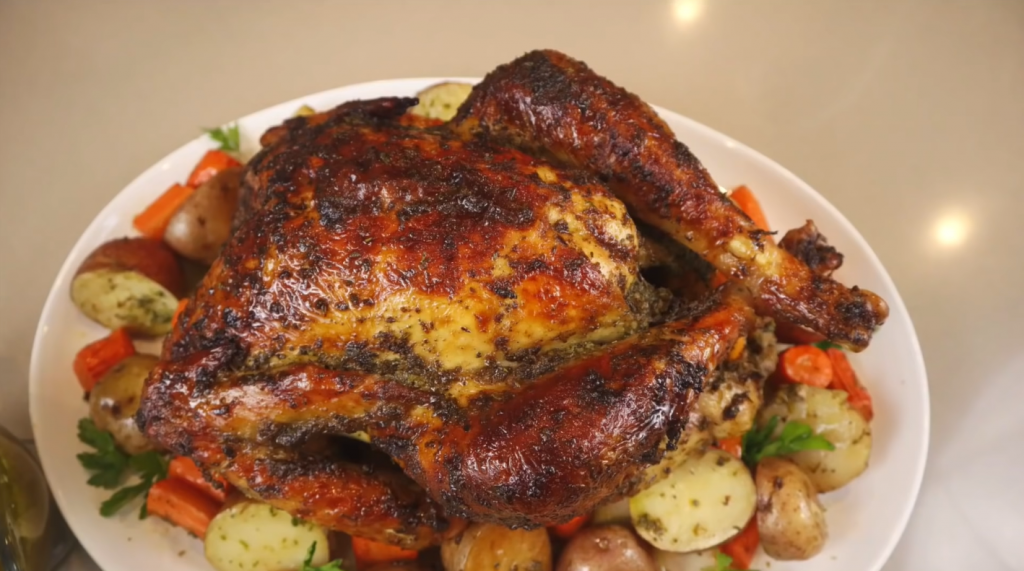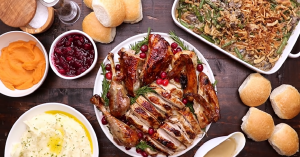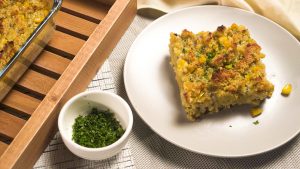A perfect roast turkey is a standout centerpiece for any special occasion. Achieving a moist, flavourful turkey with a crisp, golden brown skin is easier than you think. This homemade roast turkey recipe, laced with fresh herbs, vegetables and a hint of lemon, is sure to impress at your next holiday gathering.

Photos of Homemade Roast Turkey Recipe
The ingredients for this recipe are quite straightforward and easily found in any supermarket. One ingredient to note is the fresh herbs - rosemary, sage, and thyme. They add a unique flavor to the turkey that dried herbs can't replicate. If you don't have these fresh herbs, you can find them in the produce section of your local supermarket.
Ingredients for Homemade Roast Turkey Recipe
Turkey: This is the star of the show. A good sized turkey for roasting will be about 12-14 pounds.
Lemon: Lemon juice adds a bit of acidity, which helps to tenderize the meat and balance the rich flavor of the turkey.
Salt and pepper: Essential for seasoning the turkey.
Extra virgin olive oil: Used to rub over the skin of the turkey to help it achieve a golden brown color.
Yellow onion: Adds flavor to the stuffing and when roasted with the turkey, it adds a depth of flavor to the pan drippings.
Celery tops: These often discarded parts of celery are full of flavor and perfect for stuffing into the cavity of your turkey.
Carrots: Adds a slight sweetness to the stuffing and the pan drippings.
Parsley: Fresh parsley imparts a fresh, slightly peppery flavor to the turkey.
Rosemary, sage, and/or thyme: These herbs have a strong, distinct flavor that pairs well with turkey.
One reader, Clayborn Cerda says:





This homemade roast turkey recipe is a game-changer! The turkey turned out incredibly juicy and flavorful. The blend of herbs and lemon juice added a delightful zing. It's now my go-to recipe for special occasions. Highly recommended for anyone looking to impress their guests with a mouthwatering turkey dish!
Techniques Required for Making a Homemade Roast Turkey
How to make the gravy: After the turkey is resting, prepare the gravy by scraping off the drippings from the roasting pan. If using a thick metal roasting pan, place it directly on the stovetop burner. If not, transfer the drippings to a skillet. Use a metal spatula to scrape off any drippings stuck to the bottom of the pan.
How to make a roux with the turkey fat: Ladle off some of the excess fat from the pan, leaving about 4 tbsp of fat and drippings. Reserve the excess fat for another use. Heat the fat and drippings in the pan until bubbly. Sprinkle 1/4 cup of flour over the fat and drippings. Stir with a wire whisk to make a roux, letting the flour brown for a minute in the hot pan.
How to add liquid to make the gravy: Slowly add 3 cups of water, stock, or milk to the pan, whisking vigorously to eliminate any lumps. Let the gravy simmer and thicken. Season with salt, pepper, ground sage, thyme, or other seasonings to taste.
How to save the bones for turkey soup: After finishing the turkey, save the bones from the carcass to make a delicious turkey soup.
How To Make Homemade Roast Turkey
Thanksgiving will never be the same with this homemade roast turkey recipe. Opt to cook your turkey breast-side down so it stays succulent and rich.
Serves:
Ingredients
- 1turkey approx
- juice of a lemon
- salt and pepper
- extra virgin olive oil,or softened or melted butter
- ½yellow onion,peeled and quartered
- celery tops
- 2carrots
- 1bunchparsley
- several sprigs of fresh rosemary,or sage, and/or thyme
Instructions
-
Make the gravy while the turkey is resting covered on the carving board.
-
Use a metal spoon to ladle off some of the excess fat from the pan and reserve for another use. If using flour, heat the fat and drippings in the pan until they are bubbly. Sprinkle with ¼ cup of flour all over the fat and drippings.
-
Stir with a wire whisk to make a roux with the flour and fat. Let the flour brown a minute or so in the hot pan.
-
Slowly add 3 cups of water, stock, or milk to the pan, whisking vigorously to get rid of any lumps. Let the gravy simmer and thicken. Add salt and pepper, ground sage, thyme, or other seasonings to taste.
Nutrition
- Calories: 1191.57kcal
- Fat: 53.46g
- Saturated Fat: 12.79g
- Trans Fat: 0.44g
- Monounsaturated Fat: 21.65g
- Polyunsaturated Fat: 12.00g
- Carbohydrates: 16.15g
- Fiber: 6.70g
- Sugar: 3.24g
- Protein: 156.87g
- Cholesterol: 514.49mg
- Sodium: 1968.10mg
- Calcium: 204.45mg
- Potassium: 1997.51mg
- Iron: 9.07mg
- Vitamin A: 340.85µg
- Vitamin C: 49.28mg
Technique Tip for Achieving a Perfect Roast Turkey
To ensure your turkey is juicy and flavorful, consider brining it before roasting. Brining is a process of soaking the turkey in a mixture of salt and water, which helps to break down the protein structure of the meat, allowing it to absorb more moisture and flavor. You can also add other flavorings like herbs, spices, and citrus to the brine for an extra flavor boost. Remember to rinse the turkey thoroughly after brining to prevent it from becoming too salty.
Time-Saving Tips for Preparing Homemade Roast Turkey
Prep ahead: Chop vegetables, measure ingredients, and prepare the turkey the night before to save time on the day of cooking.
Use a roasting bag: Cooking the turkey in a roasting bag can help reduce cooking time and keep the meat moist.
Invest in a meat thermometer: Using a meat thermometer can help you cook the turkey to the perfect temperature, ensuring it's not overcooked or undercooked.
Multitask: While the turkey is roasting, use the time to prepare side dishes or set the table to save time.
Delegate: Don't be afraid to ask for help in the kitchen. Assign tasks to family members or friends to make the cooking process more efficient.
Organize your workspace: Keep all your cooking tools and ingredients organized and within reach to avoid wasting time searching for items.
Substitute Ingredients For Homemade Roast Turkey Recipe
turkey - Substitute with chicken: Chicken can be used as a lean and flavorful alternative to turkey, providing a similar texture and taste when roasted.
lemon - Substitute with white wine vinegar: White wine vinegar can add a tangy acidity similar to lemon juice, enhancing the flavor of the dish.
salt and pepper - Substitute with garlic powder and paprika: This combination can add depth of flavor and a hint of spiciness to the dish, similar to salt and pepper.
extra virgin olive oil - Substitute with avocado oil: Avocado oil has a mild flavor and high smoke point, making it a suitable substitute for olive oil in roasting.
yellow onion - Substitute with shallots: Shallots provide a milder, sweeter flavor compared to yellow onions, adding a subtle complexity to the dish.
celery tops - Substitute with celery leaves: Both parts of the celery offer a similar flavor profile, with the leaves providing a slightly stronger taste.
carrots - Substitute with parsnips: Parsnips have a slightly sweeter and nuttier flavor compared to carrots, adding a unique twist to the dish.
parsley - Substitute with cilantro: Cilantro can provide a fresh and vibrant flavor similar to parsley, adding a unique herbal note to the dish.
rosemary, sage, and/or thyme - Substitute with marjoram and tarragon: This combination can offer a similar earthy and aromatic profile, complementing the flavors of the dish.
Best Way to Present a Roasted Turkey
Elevate the turkey carving: Present the turkey on a beautiful wooden carving board, garnished with fresh herbs and lemon slices to add a pop of color and freshness to the dish.
Artfully arrange the side dishes: Place the roasted carrots and celery tops in a delicate serving dish, and arrange them around the turkey to create a visually appealing and balanced plate.
Garnish with fresh herbs: Sprinkle the turkey with freshly chopped parsley and rosemary to add a burst of color and a touch of earthy aroma to the dish.
Use elegant serving platters: Serve the gravy in a sauce boat and the side dishes in elegant serving dishes to add a touch of sophistication to the presentation.
Incorporate seasonal elements: Add a few decorative pumpkins or fall leaves around the serving platters to evoke the warmth and spirit of the season.
Create a stunning centerpiece: Place the turkey on a bed of fresh lettuce and kale leaves to create a visually stunning and appetizing centerpiece for the table.
Add a touch of gold: Consider using gold-rimmed plates or golden utensils to add a touch of luxury and elegance to the overall presentation.
Serve with flair: Carve the turkey tableside to create an engaging and interactive dining experience for the guests, showcasing your culinary expertise and adding a touch of drama to the presentation.
Essential Tools for Making a Homemade Roast Turkey
- Chef's knife: A versatile tool for chopping, slicing, and dicing a variety of ingredients.
- Cutting board: Provides a stable surface for cutting and preparing ingredients.
- Roasting pan: Used for roasting the turkey in the oven, allowing for even cooking and collecting drippings for gravy.
- Meat thermometer: Essential for ensuring the turkey is cooked to the proper internal temperature for safety and optimal flavor.
- Basting brush: Used to apply flavorful liquids, such as olive oil or marinade, to the turkey for basting.
- Aluminum foil: Used to tent the turkey while resting to keep it warm and allow the juices to redistribute.
- Carving knife: Designed for slicing and carving the cooked turkey with precision.
- Metal spatula: Useful for scraping off any drippings stuck to the roasting pan and transferring them for making gravy.
- Wire whisk: Essential for creating a smooth and lump-free gravy by incorporating the flour and liquid thoroughly.
- Skillet: Used for making the gravy if the roasting pan cannot be placed directly on the stovetop burner.
How to Store and Freeze Homemade Roast Turkey
Let the roast turkey cool completely before storing or freezing. This usually takes around 30 minutes to an hour, depending on the size of the bird.
Remove any stuffing from the cavity of the turkey and store it separately in an airtight container in the refrigerator for up to 3-4 days.
Carve the remaining turkey meat from the bones and place it in an airtight container or resealable plastic bags. Refrigerate for up to 3-4 days or freeze for up to 2-3 months.
If freezing, wrap the turkey meat tightly in plastic wrap or aluminum foil before placing it in a freezer-safe container or resealable plastic bag. This will help prevent freezer burn and maintain the quality of the meat.
To freeze the entire roast turkey, wrap it tightly in plastic wrap or aluminum foil, then place it in a large freezer-safe bag or container. Remove as much air as possible before sealing to prevent freezer burn. Freeze for up to 3-4 months.
When ready to use frozen turkey meat, thaw it in the refrigerator overnight. Never thaw turkey at room temperature, as this can promote bacterial growth and increase the risk of foodborne illness.
To reheat leftover turkey, place it in an oven-safe dish with a small amount of broth or water to keep it moist. Cover the dish with foil and heat in a preheated 325°F (165°C) oven until the internal temperature reaches 165°F (74°C).
How to Reheat Leftover Roast Turkey
The best way to reheat leftover roast turkey is to slice it and place it in a baking dish with a bit of chicken broth or gravy to keep it moist. Cover the dish with foil and bake at 350°F for about 20-30 minutes, or until the turkey is heated through.
Another option is to slice the turkey and heat it in a skillet with a bit of butter or olive oil over medium heat. This method is quick and easy, but be careful not to overcook the turkey or it will become dry.
For a quick and easy option, you can also reheat sliced turkey in the microwave. Place the slices on a microwave-safe plate and cover with a damp paper towel. Microwave on high for 1-2 minutes, or until heated through.
If you have a lot of leftover turkey, consider making a turkey soup or turkey pot pie. These dishes are a great way to use up leftover turkey and create a whole new meal.
For a tasty sandwich, try reheating sliced turkey in a pan with some bacon or prosciutto. The salty, savory flavors of the meat will complement the turkey nicely.
If you want to get creative, try making turkey quesadillas or turkey enchiladas. These dishes are a great way to use up leftover turkey and give it a new twist.
Finally, don't forget about the classic turkey sandwich. Slice the turkey thinly and pile it high on some good quality bread with your favorite toppings, such as cranberry sauce, stuffing, and mayonnaise.
Random Fact About Roast Turkey
The homemade roast turkey recipe is a classic dish often enjoyed during festive occasions such as Thanksgiving and Christmas. It is a versatile dish that can be customized with various herbs and spices to suit individual preferences. The process of making the gravy from the turkey drippings adds depth and flavor to the meal. Additionally, the leftover turkey bones can be used to make a delicious and hearty turkey soup, reducing food waste and maximizing the use of the ingredients.
Is Making Homemade Roast Turkey Cost-Effective?
The cost-effectiveness of this homemade roast turkey recipe is high, as it utilizes simple, affordable ingredients. The turkey itself is often reasonably priced and can feed a family for several meals. The addition of lemon, onion, and herbs enhances flavor without breaking the bank. With an approximate cost of $20-$25 for a 12-pound turkey and minimal additional expenses, this recipe is budget-friendly for a household of four. Overall Verdict: 9/10
Is Homemade Roast Turkey Healthy or Unhealthy?
The homemade roast turkey recipe is relatively healthy, as it primarily uses whole, natural ingredients. Here are some positive aspects:
- Turkey is a lean protein source, providing essential amino acids for muscle growth and repair
- The recipe incorporates fresh herbs and vegetables, adding flavor and nutrients
- Using extra virgin olive oil is a healthier choice compared to butter or other saturated fats
- The recipe does not include any processed ingredients or added sugars
However, there are a few potential concerns:
- The recipe does not specify the amount of salt used, which could lead to excessive sodium intake if not monitored
- The gravy, depending on the amount consumed, may add significant calories and fat to the dish
- The skin of the turkey, while flavorful, is high in saturated fat
To make this recipe even healthier, consider the following suggestions:
- Use a low-sodium broth or stock for the gravy to reduce overall sodium content
- Opt for a whole wheat or gluten-free flour to make the gravy, increasing fiber intake
- Remove the skin from the turkey before serving to reduce saturated fat consumption
- Incorporate more vegetables into the dish, such as roasted root vegetables or a side salad, to increase nutrient density
- Use fresh herbs liberally, as they add flavor without additional calories or fat
- Experiment with yogurt or milk-based gravies for a lower-fat alternative
By making these simple adjustments, you can enhance the nutritional value of this classic homemade roast turkey recipe without compromising on taste or tradition.
Editor's Thoughts on This Homemade Roast Turkey Recipe
As a culinary expert, I find this homemade roast turkey recipe to be a classic and reliable method for preparing a delicious turkey. The use of lemon juice, fresh herbs, and vegetables will infuse the turkey with wonderful flavors. The instructions for making the gravy are clear and helpful, ensuring a rich and flavorful accompaniment to the turkey. The suggestion to save the bones for making turkey soup is a great way to minimize waste and maximize flavor. Overall, this recipe provides a solid foundation for a traditional and satisfying roast turkey dinner.
Enhance Your Homemade Roast Turkey Recipe with These Unique Side Dishes:
Alternative Recipes Similar to Homemade Roast Turkey
Suggested Appetizers and Desserts for a Roast Turkey Dinner
Why trust this Homemade Roast Turkey Recipe:
This homemade roast turkey recipe is a trusted classic, perfected over generations. The turkey is seasoned with lemon juice for a hint of brightness, extra virgin olive oil for richness, and a blend of aromatic herbs like rosemary, sage, and thyme. The method for making the gravy is tried and true, ensuring a rich and flavorful accompaniment to the turkey. With a focus on traditional flavors and techniques, this recipe embodies the essence of a timeless, delicious roast turkey.
Was this page helpful?
Have your own special recipe to share? Submit Your Recipe Today!











